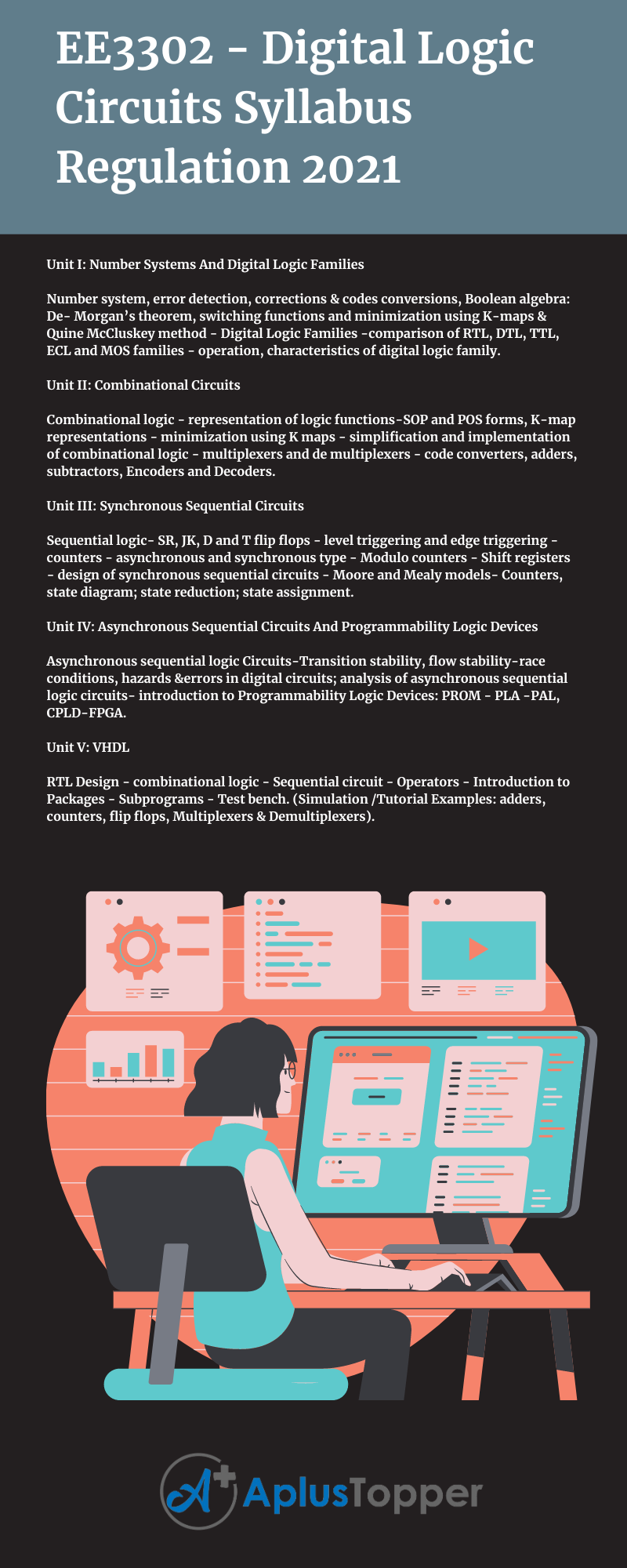The article contains the subject code EE3302, which deals with the Anna University B.E Electrical and Electronics Engineering Semester – III Digital Logic Circuits Syllabus. Unit wise detailed syllabus of this subject EE3302 is included in this article. You can get assistance for note preparation or can understand the chapters contain topics in one place.
Effective results need effective preparation and having the required knowledge of the topics included in the subject. If you want to perform well in academics proper guidance and the subject syllabus in mind are necessary, this article EE3302 – Digital Logic Circuits Syllabus will fulfill the details regarding your preparation.
If you want to know more about the syllabus of B.E Electrical and Electronics Engineering connected to an affiliated institution’s four-year undergraduate degree program. We provide you with a detailed Year-wise, semester-wise, and Subject-wise syllabus in the following link B.E Electrical and Electronics Engineering Syllabus Anna University, Regulation 2021.
Aim Of Objectives:
- To introduce the fundamentals of combinational and sequential digital circuits.
- To study various number systems and to simplify the mathematical expressions using Boolean functions word problems
- To study the implementation of combinational circuits using Gates’ and MSI Devices.
- To study the design of various synchronous and asynchronous circuits
- To introduce digital simulation techniques for the development of application-oriented logic circuit
EE3301 – Electromagnetic Fields Syllabus
Unit I: Number Systems And Digital Logic Families
Number system, error detection, corrections & codes conversions, Boolean algebra: De- Morgan’s theorem, switching functions and minimization using K-maps & Quine McCluskey method – Digital Logic Families -comparison of RTL, DTL, TTL, ECL and MOS families – operation, characteristics of digital logic family.
Unit II: Combinational Circuits
Combinational logic – representation of logic functions-SOP and POS forms, K-map representations – minimization using K maps – simplification and implementation of combinational logic – multiplexers and de multiplexers – code converters, adders, subtractors, Encoders and Decoders.

Unit III: Synchronous Sequential Circuits
Sequential logic- SR, JK, D and T flip flops – level triggering and edge triggering – counters – asynchronous and synchronous type – Modulo counters – Shift registers – design of synchronous sequential circuits – Moore and Mealy models- Counters, state diagram; state reduction; state assignment.
Unit IV: Asynchronous Sequential Circuits And Programmability Logic Devices
Asynchronous sequential logic Circuits-Transition stability, flow stability-race conditions, hazards &errors in digital circuits; analysis of asynchronous sequential logic circuits- introduction to Programmability Logic Devices: PROM – PLA -PAL, CPLD-FPGA.
Unit V: VHDL
RTL Design – combinational logic – Sequential circuit – Operators – Introduction to Packages – Subprograms – Test bench. (Simulation /Tutorial Examples: adders, counters, flip flops, Multiplexers & Demultiplexers).
Textbooks:
- Morris Mano.M, ’Digital Logic and Computer Design’, Prentice Hall of India, 3rd edition, 2005.
- Donald D.Givone, ‘Digital Principles and Design’, Tata McGraw Hill,1st Edition, 2003.
- Thomas L Floyd, ‘Digital fundamentals’, Pearson Education Limited, 11th Edition, 2018.
References:
- Tocci R.J., Neal S. Widmer, ‘Digital Systems: Principles and Applications’, Pearson Education Asia, 12th Edition, 2017.
- Donald P Leach, Albert Paul Malvino, Goutam Sha, ‘Digital Principles and Applications’, Tata McGraw Hill, 7th Edition, 2010.
- Tata McGraw Hill, 7th Edition, 2010.
Related Posts Of Semester – III:
